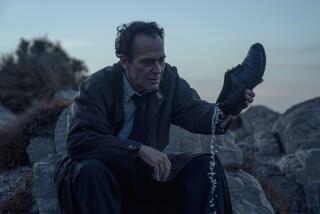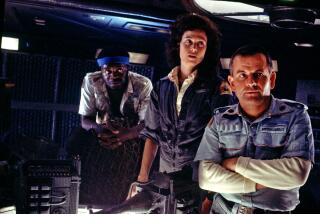Marcel Vercoutere dies at 87; special effects wizard on ‘The Exorcist’
Long before the age of computer-generated special effects, Marcel Vercoutere helped create a scene widely considered among the most terrifying in movie-going history.
In “The Exorcist,” the 1973 horror film that became a pop-culture phenomenon, the head of a helpless young girl twists completely around as a young priest battles the demon that inhabits her body. With its wild, animated eyes, the life-size robot used as a stand-in for actress Linda Blair was built by Vercoutere, the film’s special effects director, with help from its chief makeup artist, Dick Smith.
Vercoutere, the special effects innovator who solved that technical challenge and others for “The Exorcist” and other films, died April 13 at his home in Burbank. He was 87.
The cause was complications of dementia, said his son Dan.
A self-taught welder, carpenter, set designer and explosives expert, Vercoutere was a creative, unruffled presence on the set of “The Exorcist,” said Owen Roizman, the film’s Oscar-nominated cinematographer.
“He had made this unbelievable robot and everything about it worked — it almost had facial expressions,” Roizman said last week. “I was standing there looking at it and I said, ‘You know what, we forgot something. We don’t have any breath coming out.’ Marcel just said, ‘I’ll deal with that.’ He was so calm. And before you know it ... the dummy had breath.”
“He was the guy we would all turn to when we needed a problem solved.”
Marcel Vercoutere Jr. (pronounced “ver-coo-tehr”) was born in Detroit on Oct. 28, 1925, the youngest of three brothers, and grew up in nearby Grosse Pointe. His father, Marcel, was an immigrant from France; his mother, the former Augusta Verstraele, had come from Belgium.
Eager to fight in World War II, Vercoutere Jr. tried to join the Navy at 16, his son said, but was turned away. The next year, he enlisted and spent three years in the Pacific theater, serving part of that time on the Peiffer, a destroyer.
After the war, he returned to Michigan, earned his high school diploma and worked as a welder. In 1954, he married Carolyn Hill, whom he had met at a motorcycle rally. She survives him, along with their sons Dan and Jon, stepdaughter Charlotte Brooks and a brother, Albert.
After marrying, the couple headed for Los Angeles, where Vercoutere found work at the area’s movie studios, first sweeping stages, then as a welder and carpenter. Eventually, he became part of the creative team for various films, designing special effects and stunts for car crashes, exploding bridges, gunbattles and other scenes.
Special effects, Vercoutere said, was thoroughly addicting.
“All of us on motion picture crews have said at one time or another, ‘I hate this job, it’s terrible and I’ll never do it again,’” he told The Times in 1981, when he was working at The Burbank Studios. “But when you see the product, you always come back for more.”
Vercoutere created special effects for the fire and gunfights in “McCabe and Mrs. Miller” in 1971 and the perilous river scenes in “Deliverance” in 1972, along with effects for a number of television movies and series. But he was best known for his work on “The Exorcist,” the William Friedkin-directed film that was nominated for an Academy Award for best picture. It would win two Oscars, for best sound and for best screenplay, by William Peter Blatty, who adapted his best-selling novel.
Vercoutere’s talents figured in many memorable scenes. He used various techniques, including hidden wires, pulleys and offstage supports, to create the possessed child’s violently shaking bed, along with her frightening levitation. He also built the set for the film’s bedroom, where most of the action takes place, inside a giant refrigerated cocoon, to achieve Friedkin’s desire for an icy atmosphere whenever the girl is possessed.
“If I had to name one person behind the camera whose contributions meant the most to the film, it would be Marcel Vercoutere,” Friedkin said in an emailed statement.
After creating the film’s life-size dummy and mechanical head, Vercoutere and colleagues decided to try it out near the film’s New York set, he said in a 1998 BBC documentary, “The Fear of God: 25 Years of ‘The Exorcist.’ ”
“We put it in the front seat of a taxi in the summertime in New York City,” he said, chuckling. “And the people would stare at this thing and finally it would spin its head around, and that was it.”
More to Read
Start your day right
Sign up for Essential California for the L.A. Times biggest news, features and recommendations in your inbox six days a week.
You may occasionally receive promotional content from the Los Angeles Times.






